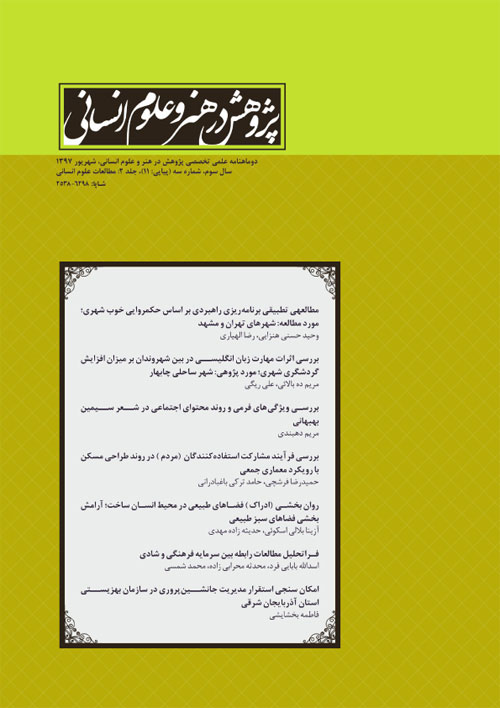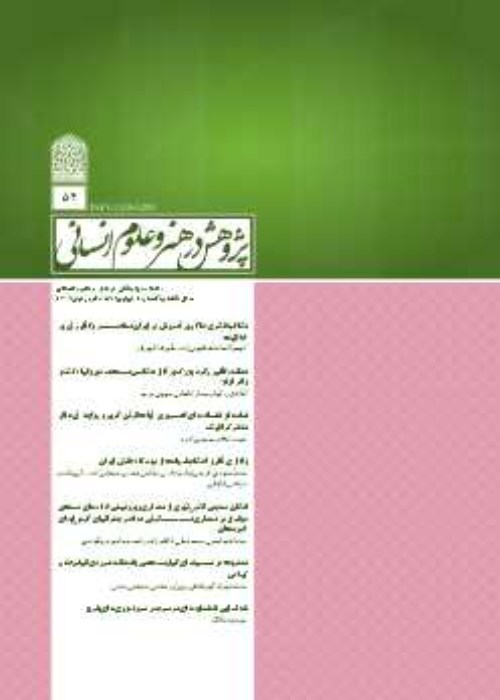Javad Divandari, Salman Noghrekar, Farideh Sadat Hosseini Sharif *
Page 17
All children are born in pure and perfectionist nature. In fact, training and attitude of their family and community makes people courageous and decent or faded and indecent. The opinion of many education professionals is that the human person is formed in the first six years of his life. Given that the human spirit is flexible at the time of childhood, and as the human becomes larger, its flexibility reduces, it should be child development fields provided. Due to the significant impact the environment as one of the factors affecting child development, Especially the impact of architectural space In improving physical and motor abilities and Also, children's mental, emotional and social development, In order to design a space that meets the needs of children, we need to know the exact characteristics of the child's development. Since the teachings of Islam are the guide to the development of human perfections and this guidance guide addresses all aspects of human existence and life, Here is the question that the Islamic thought of what solutions are offered on a child's development environment. Given the changing pattern of traditional family life in recent decades, pre-primary education spaces are emerging as a real need, and we should recognize that the characteristics of a suitable kindergarten for the development of a child are based on Islamic teachings. The purpose of this article is to provide Islamic principles and patterns for the design of kindergartens. In this article, we tried to use the Islamic approach and the concept of growth from the viewpoint of Martyr Motahari and Ibn Sina, With the method of logical reasoning and interpretation and analysis of the principles, goals, and educational methods of them, to conclude the components and environmental qualities of appropriate place for the child's development. And Ultimately, the principles for designing the child's space in accordance with these qualities and conditions are extracted. The main goal of development from the view of Islam and the Quran, as well as muslim scholars, is divine proximity and succession that is considered as the ultimate goal of Islamic education, and education provides the path to the goal of growth. Given the ultimate goal of man, to reach the path of development, muslim scholars explained goals, principles and methods. Among those, there are some things that can be effective in the quality of the place (here's a kindergarten), In this study, the quality and environmental factors enumerated. For example, according to the principle of "group training" as one of the educational principles of Ibn Sina, it is possible to use game-based learning methods that allow participation in group activities. Therefore, it is necessary to create a child's develope field by creating flexible spaces with dimensions and shapes and suitable furniture for forming small and large groups. In the field of architecture, in order to realize these environmental qualities, we need methods and tools, for this purpose, we have outlined the principles of designing the physical environment in various fields (Physical planning, materials, interior design, etc.). In fact, the experience of each person in their lives and the skills they acquire is related to the environmental conditions and the result of the interaction between the person and the environment in which he lives. The design of special spaces for children such as kindergartens is important because during these years the child is more affected by the environment, While most of these spaces in Iran are not suitable for children. The physical environment with its elements such as color, texture, bright shadow, light, sound, form, etc., creates different spatial qualities and affects the child's body and mind. In this way, in accordance with the environmental factors include principles such as spacious and massive spaces, create outdoor amphitheater and use U-shaped center-shaped forms for furnitures outdoor and indoor . It can be said that kindergarten in Islamic thought is a place for child's developement in the direction of divine proximity. Obviously, human and environmental factors are effective in the child's development, therefore, by interpreting and analyzing the goals, principles and methods of Islamic education, we highlight the environmental qualities that are effective in develope, and thus we have introdused principles for architectural designing kindergarten.
Given the relationship between man and himself, God, society and nature, these principles can be summarized as follows:1- Relationship between child and himself:- A space for child privacy, such as under stairs or small cottages.
2- Relationship between child and god:- Laying coach' prayer room exposed to the children's View.
3- Relationship between child and society:- Shared dining for children and coaches and parents.
- Social spaces for group play and training.
4- Relationship between child and nature:- Use natural materials.
- Create wide openings at the child's eyes.mentioned, we draw the principles for
designing the child's environment for the purpose of his development. For example above, we can



